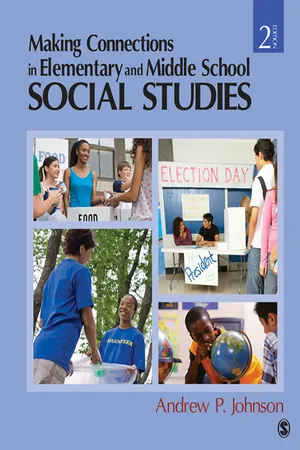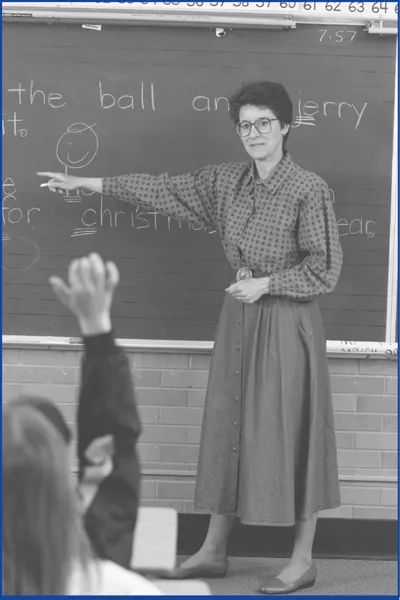![]()
SECTION III
Instructional Strategies in Social Studies
Chapter 5. Instructional Models in Social Studies
Chapter 6. Differentiating the Curriculum Using Inclusive and Multilevel Practices
Chapter 7. Teaching Cognitive Processes in Social Studies
Chapter 8. Inquiry Learning in Social Studies
Chapter 9. Learning Through Human Interaction
This section provides a comprehensive overview of the various types of instructional strategies that can be used in the social studies curriculum. Chapter 5 focuses on the instructional models that can be used and offers a wide range of examples of how to incorporate these instructional models into the classroom. Chapter 6 provides strategies for differentiating instruction, particularly for English language learners (ELL) and highly creative or gifted learners. Chapter 7 discusses the importance of thinking skills and problem solving in social studies and provides examples of projects and activities that can be used in the classroom. Chapter 8 explores inquiry learning, particularly discussing inductive analysis, surveys and interviews, and the inquiry process and how to implement it. Finally, Chapter 9 discusses the importance of learning through human interaction and focuses on cooperative learning, communication skills, and using classroom discussions effectively. Together, these chapters provide comprehensive coverage of the important instructional strategies needed for teaching social studies.
![]()
Chapter 5
INSTRUCTIONAL MODELS IN SOCIAL STUDIES
Thinking Ahead
- What comes to mind when you hear the phrases teacher-centered instruction and learnercentered instruction?
- How do you like to learn in a classroom? How do you learn best in a classroom? Consider your responses here as you read about the various instructional models in this chapter.
- Is there one type of instructional model or strategy that is the best or most effective? What do you think it might be?
This chapter describes two different types of instructional models: teacher-centered instruction and learner-centered instruction. These models provide two differing ways of thinking about teaching and learning experiences.
TEACHER-CENTERED INSTRUCTION
This first section focuses on three instructional models, all of which can be said to be teacher centered. Here, the teacher designs and is primarily responsible for transmitting knowledge directly to the students in a very controlled, sequential manner, fully in control of all parts of the lesson (Borich, 2006; Kauchack & Eggen, 1998). Described below are three types of teacher-centered instructional models: direct instruction, expository teaching, and mastery learning.
DIRECT INSTRUCTION
Direct instruction is a very structured form of teaching where students receive information directly from a teacher. Here, the responsibility for students’ learning rests firmly on the teacher. The teacher sets the purpose for the lesson, explains exactly what the students are to learn, and evaluates learning based on students’ ability to replicate or regurgitate predetermined knowledge or skills.
Direct Instruction Components
There are a variety of forms of direct instruction, each of which includes some or all of the following eight components.
1. Clearly Defined Objective. A clearly defined objective is a statement that describes exactly what you want students to learn. As described in Chapter 3, objectives can be stated in behavioral terms (a behavioral objective) or in cognitive terms (a cognitive objective). A clearly stated objective defines the learning experience and provides focus for your lesson. You are not simply designing an interesting experience or creating a fun activity; you are planning a purposeful learning experience to teach a specific body of knowledge or set of skills.
2. Orientation. Orientation occurs during the initial part of direct instruction. Here, the teacher tells students exactly what the lesson objective is and gives an overview or preview of what is to come. This provides learners with the big picture so that they are able to contextualize the information they will receive. Seeing the structure of what is to be learned (the big picture) helps students process and encode new information. In contrast, simply presenting discrete bits of information without a sense of context can be confusing, especially to those students with a limited knowledge base.
Orientation might also involve connecting new knowledge to old knowledge in order to enhance students’ ability to understand and encode this new knowledge. To make this connection, a teacher may do a brief review of previously learned or relevant information. Another connecting technique is the KWL chart (see below). Orientation should be kept fairly brief (from 1 to 3 minutes in duration).
Direct instruction is a very structured form of teaching.
EXAMPLE: A KWL CHART
As part of her unit on Minnesota-based Native Americans, Ms. Jamison was teaching a lesson on how the Chippewa Indians got their food in the days before white settlers. Before starting her lesson in her secondgrade classroom, Ms. Jamison puts a KWL chart on the board (see below). She asks students what they know about early Native American tribes’ food, specifically, what they ate and how they got it. Their responses are listed in the first column. She then asks students what they want to learn about this topic in the upcoming lesson. These responses are listed in themiddle column. At the end of the lesson, she asks students to list things they have learned about this topic and check to see if anything in the “know” column needs to be corrected. As students become familiar with this technique, they can eventually do their own KWL charts in small groups or individually in their learning logs or journals.
The KWL chart is also an effective prereading activity to use when reading expository text (informational text such as textbooks). The first two columns are filled in before reading. Students are then asked to list three to five things in the last column after completing the assigned reading. It is also a form of advance organizer (see below).
3. Well-Organized, Sequentially Planned Lessons. The next component of direct instruction is a lesson plan that is well-structured and designed to make optimal use of instructional time. Effective planning enhances learning and reduces classroom management issues (Freiberg & Driscoll, 1992). Lesson plans of any kind should contain the following: (a) the sequence of events, (b) the specific information given to students, (c) possible discussion questions, and (d) activities used to manipulate input or information. However, having a well-organized lesson plan does not mean that you cannot deviate. It just means that a plan has been developed before the learning experience began.
4. Input. The input is the specific information that you want students to know. If you are teaching a skill (procedural knowledge), this would include a description of the skill, how to use it, and the specific steps. If you are teaching a concept (declarative knowledge), this would include the defining attributes and other background information that students need to know. In each situation, the input for a direct-instruction lesson should be well-organized, with a logical structure to enhance students’ assimilation and encoding of information (Rosenshine, 1988). This again points to the importance of planning.
5. Guided Practice. When teaching a concept, guided practice involves having students categorize the concept or manipulate the new information under the guidance or observation of the teacher. The goal is for them to use, apply, or try out new content as the teacher monitors in order to assess learning (formative assessment). Small-group activities can be effective here because they enable the teacher to see many students simultaneous and to hear their thought processes as they discuss ideas with others. When teaching a skill, guided practice involves the teacher taking the whole class through each step of the skill together.
EXAMPLE: GUIDED PRACTICE
Guided practice for teaching a concept: Mr. Burns. Mr. Burns was teaching the concept of progressives and conservatives in regards to political views in his seventh-grade civics class. He started by giving the defining attributes of a progressive point of view. He presented both examples and non-examples. He then gave defining attributes of a conservative po...


